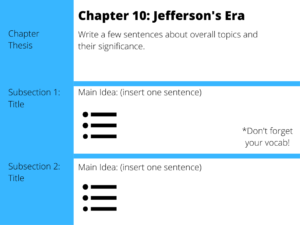Have a set of notes due tomorrow? Let's make sure that you understand how to simplify note-taking for APUSH. Follow these strategies to learn how to take helpful and concise notes based on the Cornell Template.
Why are Cornell style notes the best format to use when writing notes for APUSH? The template provides structure and organization in your notes, allowing you to continue the flow of thoughts, connections, and ideas that you make while you write. It's faster and convenient to have notes for each subsection, outlined from the chapter, instead of writing bullets that aren't focused around a specific topic discussed in the topic. This means you can refer back to your notes and review the concepts that you don't remember without having to skim all of the notes. (Refer to the template below to see a detailed explanation on how to take Cornell notes.)
-----
Key Tips
-
- Focus on the main idea- Write down key terms- Engage yourself in the reading
(1) Use Cornell-style notes.
This format builds a focus around the main points per subsection. Taking notes per subsection enables you to understand the key concepts and it removed the cluttered nature of traditional notes. The template helps organize key concepts and terms as you move throughout the chapter.
(2) Write the main idea and use bullets.
For each subsection, write one sentence as the main idea along with some bullet points to summarize the most important parts of the reading. Try to stay away from writing small details and focus on the big picture. Ask yourself, "What are the most important ideas being conveyed in the text?" Being able to identify significant points in chapter subsections is crucial because you develop historical contextualization and analysis skills that are useful on the free-response section of both AP and school exams.
(3) Highlight/underline/circle important vocabulary within the time period.
You might ask: why does vocabulary matter? It's useful because on an LEQ, DBQ, or SAQ (free-response), you can use your understanding of key terms to build your point. Vocabulary counts as outside evidence if you are able to explain how a specific term/phrase establishes the thesis's validity. It also helps you on the MCQs because even if you don't understand all of the choices or given documents, you'll still be able to eliminate answers based on your prior knowledge of key terms and time periods.
(4) Form connections with the text by relating it to events, people, or objects you're familiar with!
This will boost your understanding of what you're reading instead of memorizing details. Forcing yourself to absorb the information from the chapter won't help you remember the main points. For example, WW2 was a war between Japan (Axis Power) and America (Allied Power) where both nations took war prisoners. The movie "Unbroken" featuring Jack O'Connell, showed how the captured pilots were treated by Japanese military officials. This connection to a movie that you may have seen will help you remember one aspect of WW2 in a simple way.
(5) Summarize the chapter without referring back to your notes.
You can self-test your memory to see how much you remembered vs what topics you don't feel confident on. Self-assessments through flashcards and mini-quizzes will help you remember the content ahead of time so that you don't need to cram information into your brain before a quiz or test.
Using the Cornell Note-Taking Template

(1) Start with the chapter thesis.
Once you've read the chapter overview from the beginning of the chapter, develop a thesis about the major points that are explained in the chapter. This is essentially where you establish the claims found in the chapter. Don't forget to include the impact of those events and ideas. *You don't have to write the thesis first. You can always write the thesis after you're done with the notes and reading. Do what you feel most comfortable with.
(2) Label the subsection name on the margin of the lined paper.
After reading each subsection, begin by writing "Main Idea:" and insert the central point discussed. Next, write 3-4 bullets about what was explained in the text and the historical effects. *Don't forget to include relevant vocabulary terms throughout each subsection. You could also write all of the vocab in a separate section if you'd like the terms in one place. It's all up to you!
(3) At the end of the chapter, write a summary.
Summarize the major points and show your analytical skills using specific evidence or by making references to similarities, differences, causation, change/continuity, etc. It shouldn't be a long paragraph, just stick to a couple of sentences that deliver the message in a straightforward manner.
Dealing with the Workload: Don't stress out about having several chapters due. Notes are meant to help you retain the information you read; they're not meant to be frustrating. If you find yourself feeling overwhelmed by the workload, focus on one set at a time and keep a "ready-to-learn" mindset. Feel free to take breaks to refresh your mind in between sections as well!
You are more than capable of succeeding in APUSH; focus on your goals and you'll be fine. Anything is possible if you put in the time and effort!